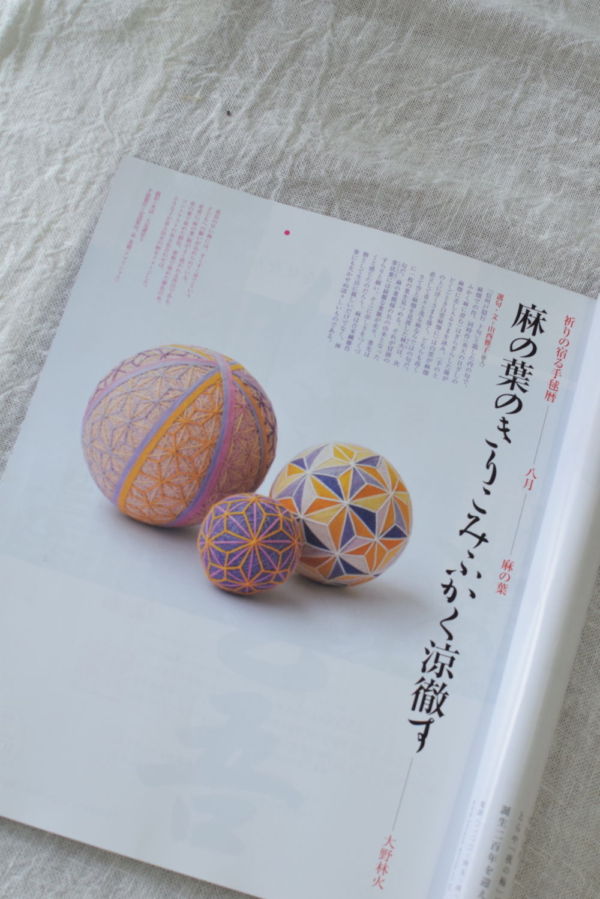This is TEMARICIOUS past blog archive written by Rika.
2019.07.09
Although the rainy season is in full swing in Tokyo, the August issue of Keitai Gaho has already been released on July 1st. How are you all doing?
The theme of August's ``Prayer-filled Temari Calendar'' is ``Asanoha''.
Most people who make temari probably love the hemp leaf pattern, which is a traditional pattern that is so good to make and so good. It is a pattern that appears in Temaricious's Temari class after about 6 basic classes, and everyone loves it.
Recently, we have seen hemp leaf tiles being used for the interior of stores and downtown areas, and when it comes to traditional Japanese patterns, the motif of "hema leaf" is loved all over the world, and it is a geometric pattern that gives a sense of the depth of Japan. I think he is a representative player. The Asanoha tiles that I like are apparently made by Nagoya Mosaic Industry Co., Ltd.
This time's haiku is
As the hemp leaves grow and cool down
Rinka Ohno
It's a landscape of a hemp field in Shinshu, and I've only seen pictures of hemp fields so I'd like to see it someday. The cut part of a hemp leaf (cannabis plant) is well represented by a geometric triangular pattern in the hemp leaf pattern.
We had a strategy meeting with the editorial department because we wanted to deliver "coolness" to everyone along with this haiku that includes the words "hemp leaves" and "coolness."
I suddenly noticed that it was ``colored like a child's yukata.'' So we decided on the colors orange, purple, and pink. The image is that the pattern on the yukata that children wear to summer festivals is hemp leaves. There are many temari with hemp leaf patterns, but we have created a wide variety of temari with a balance in mind, including large ones, ones with detailed patterns, and ones with tightly layered threads.
The three hemp leaf temari in this month's issue were made by three people.
Temari-chan, which looks like a large candy cane, was also created with a lot of effort and effort. Thanks to that, Temari-chan was able to level up Temaricious. (It takes a lot more time than it looks!)
The tightly packed hemp leaves are made of 10 different colors, and there are certain rules for their arrangement. When I drew the edges with a faint pink line, the hemp leaf pattern stood out very clearly. I was so excited to get this far.
The little Asanoha temari is adorable to the temari students who started playing temari and now even sleep with the temari even though everyone around them told them, ``You can't do temari!'' and ``It'll never last!'' I had him make hemp leaves.
They are arranged to look like children going out together in yukata at a summer festival.
Well, the summer vacation season is almost here.
What do you do during summer vacation?
Are you excited?
If you are too tired, don't push yourself too hard and take a rest.
May it be an irreplaceable summer for everyone!
The hemp leaf pattern is very popular as a gift.
Hemp leaf temari are purchased for baby's birthday celebrations and festivals, as well as for adults to ward off evil spirits. We also accept orders for Temari.
Click here → Temalicious Online Shop
Auspicious pattern of <hemp leaves>
In Japan, hemp thread and cloth have been used in Shinto rituals since ancient times. The hemp leaf pattern has the meaning of warding off evil spirits.
<Hemp leaf> is well known as a pattern used for baby clothes.
The family's wish is for the hemp to grow tall and straight, with firm roots in the earth, and to grow strong and healthy.
It is said that in the era when pure silk white uchikake was made as a bridal gown, it was transformed into a baby's swaddling clothes, and hemp leaf patterns were sewn on to protect against evil spirits.
Heartfelt prayers for the growth of children are one of the things that will never change.
The temari pattern of hemp leaves creates a beautiful pattern as it goes around the surface and returns to the beginning of the stitch.
The dots connect to form lines, and the lines overlap to form a band, which seems to represent the connection between people and lives.
[Talisman, good health]






